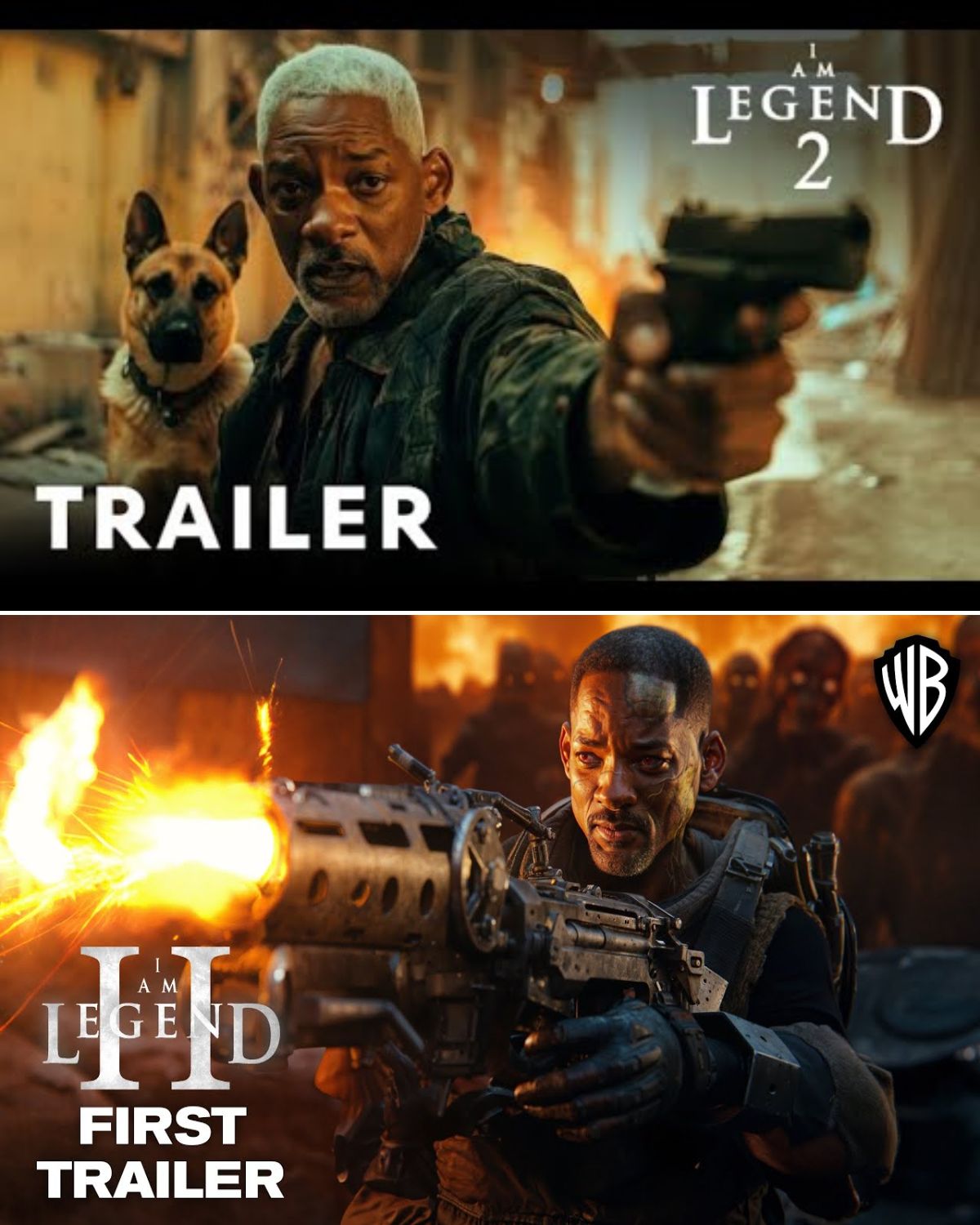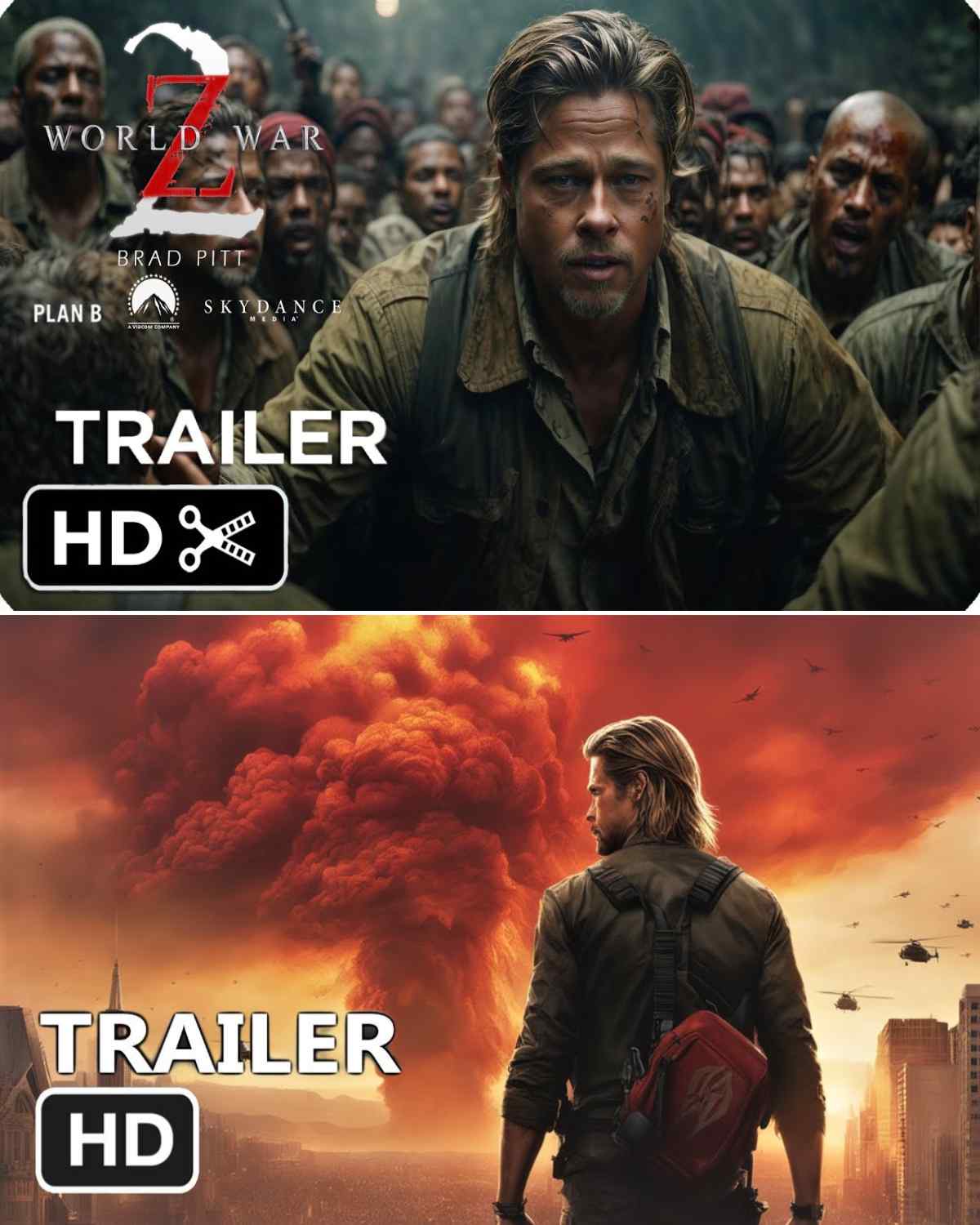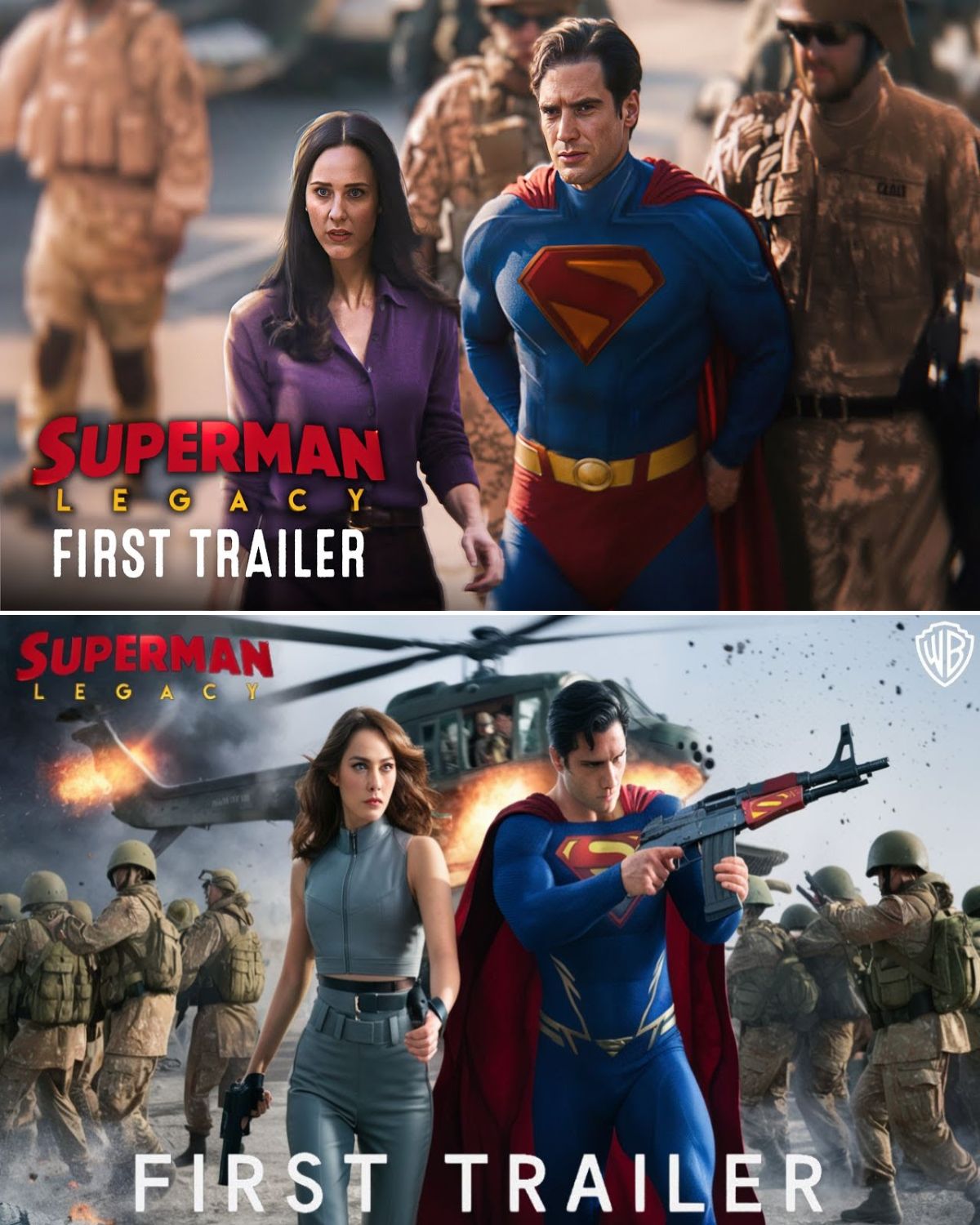Most Marvel movies revolve around a mixture of superpowers, mutants, aliens and gods, but all that stuff doesn’t just happen naturally: the men and women working tirelessly behind the scenes to create those illusions are the real heroes.
When we watch a superhero movie, we’re fully aware that some of what we’re watching was created digitally, though the sheer amount of visual effects needed to bring a Marvel movie to the big screen is staggering—some of the more recent releases have relied on the contribution of VFX artists for up to 98 percent of total shots.
That’s a lot, but it’s the Marvel way: the studio’s films have always relied heavily on CGI, and we’ve peered behind the scenes of their blockbusters to bring you definitive proof. From MCU classics to the latest hits from Fox’s resurgent X-Men franchise, these Marvel movies all look totally different before the special effects are added.
Iron Man (2008) – Armor up
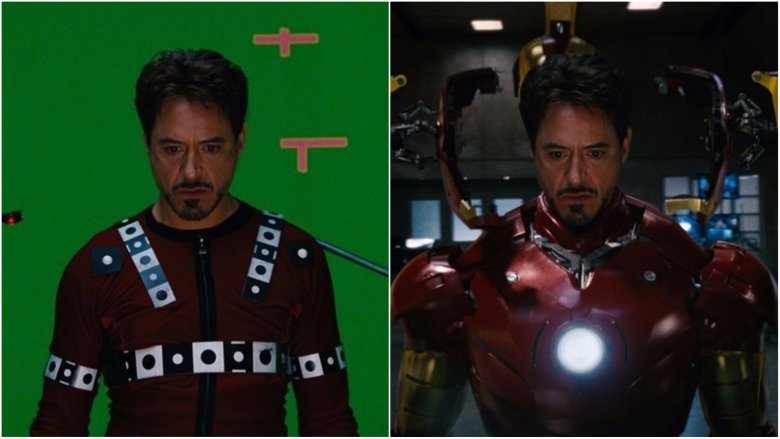
As the Marvel Cinematic Universe nears its tenth anniversary, the man who helped start it all still remains a pivotal figure in the franchise. Casting Robert Downey Jr. as Tony Stark was seen as a strange move by Marvel at the time (director Jon Favreau had to stand his ground with the studio over his choice), but it turned out to be a wise move. Downey slipped into the role of Iron Man like he’d been playing it all his life, though the character would have been nothing but grey jumpsuits and green screen if it weren’t for a team of VFX artists from Industrial Light and Magic.
Favreau told Rotten Tomatoes that too many movies were overusing CGI and insisted that he opted for practical effects where ever possible on Iron Man. He and his effects supervisor John Nelson worked with Stan Winston’s studios to build actual Iron Man suits, but if a shot just couldn’t be achieved practically, the ILM guys would step in. “A lot of them had worked on Transformers,” Favreau said. “We got to benefit from a lot of the technology they broke through for that production which really makes Iron Man photo-real. As you might know, I’m not a fan of CGI per se, so I was very demanding that we make the effects as photo-real as possible.”
Iron Man 2 (2010) – Armor up, cont’d
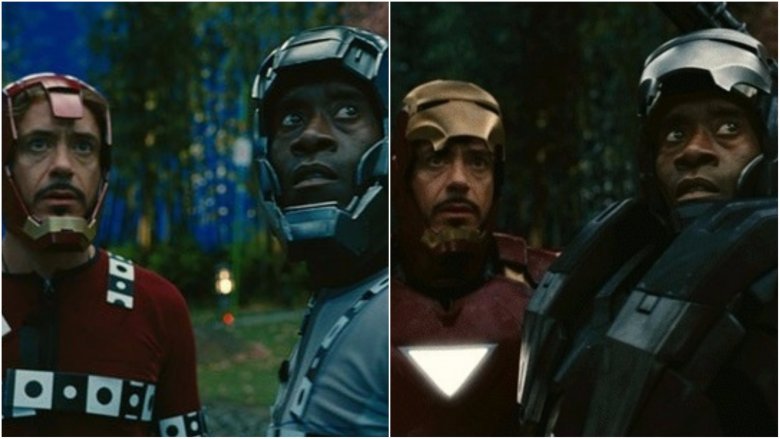
Favreau also told Rotten Tomatoes that he was more than willing to return for a second Iron Man film if the first succeeded, and when it did just that, the director got his wish. The titular hero had some new tech to play with in his second outing, including his brand new Mark V suit. When the film’s co-villain Whiplash (Mickey Rourke) starts slashing F1 cars in half mid-race at the Monaco Grand Prix, Iron Man is forced to utilize this mobile armor, which was designed from scratch by special effects house Double Negative.
“The Mark V armor was separate from the work ILM did and there was no overlap of the work on this project,” Double Negative’s Ged Wright told Art of VFX. “Legacy built a 1/3 size model which we used as a starting place, which was then refined and added to throughout the project.” Wright (who went on to work on Man of Steel and the Godzilla reboot) revealed that they were still modeling the suit and suitcase very late in the day, as the Mark V was made up of over 3000 individual pieces.
Captain America: The First Avenger (2011) – Steve’s transformation
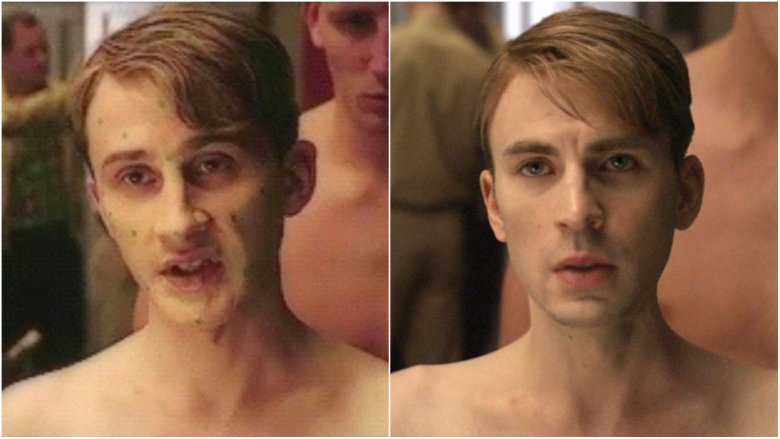
Captain America: The First Avenger was the fifth overall MCU entry and Chris Evans’ debut as Steve Rogers, a scrawny New Yorker who becomes an all-American super soldier after agreeing to take part in a military experiment. Evans got jacked for the role, though his bulky frame meant that filming the scenes that took place before he becomes Captain America were very tricky. The visual effects department were able to shrink Evans’ actual body for some shots, but they also used a body double named Leander Deeny.
“Leander is the unsung hero of this,” visual effects supervisor Edson Williams told TheWrap. “He was very dedicated and he was very aware of mimicking Chris’ timing. It’s his biggest credit and it’s a role where you never see his face.” Williams’ company Lola turned Armie Hammer into twins for The Social Network, though putting Evans’ head onto a much smaller frame proved a far more taxing challenge. “The head replacements were tricky, because you were taking the head of a rhinoceros and putting it on the body of a gazelle,” he said. “The difference in muscles, in connective tissue was so vast, that it was very difficult to make the necks match up.”
Captain America: The Winter Soldier (2014) – Peggy’s deathbed
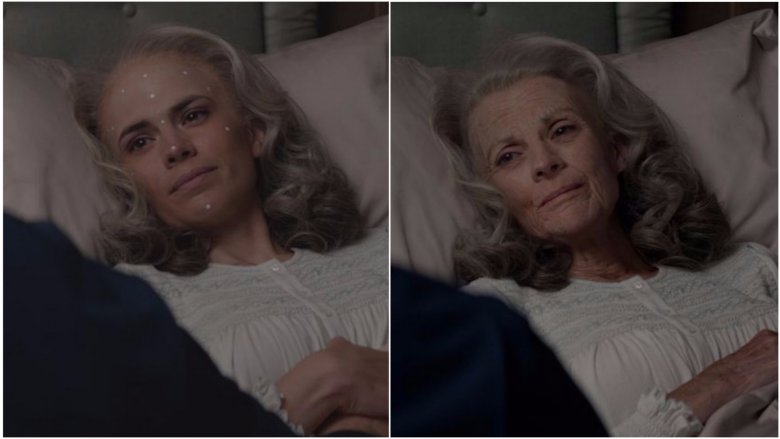
Joe and Anthony Russo replaced Joe Johnson at the helm for the second Captain America movie, but the new directors decided to stick with Lola for their special effects. The London-based VFX house resurrected skinny Steve Rogers for a flashback scene, but their main task was making Cap’s sweetheart Peggy Carter (Hayley Atwell) an old lady. Elderly lookalikes were brought in and prosthetic makeup was tested, though the results weren’t quite what they were looking for.
“I said, ‘Let’s try something that we’ve never done before,'” Edson Williams told FX Guide. “I wanted to take the performance of the elderly woman that we had shot in a rig with eight cameras and project the skin onto the original Hayley footage that had been shot on set.” Williams took still frames of the woman’s skin and added them to the original photography, and the results were spectacular. “It looked so good,” the VFX supervisor said. “The way we did it—it was amazing. You could still see Hayley, her eyes, her mouth, her underlying structure, but we just lifted the creases and cracks and age from the elderly woman and transposed it onto Hayley’s young face.”
Guardians of the Galaxy (2014) – I am bodysuit Groot
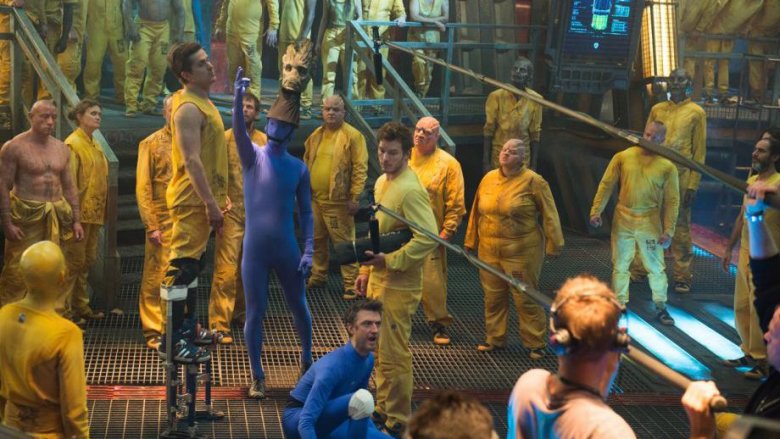
The VFX team behind Marvel’s nostalgic space opera Guardians of the Galaxy received Oscar nominations for their hard work, which most notably included the creation of two main CGI characters in Rocket Raccoon (Bradley Cooper) and Groot (Vin Diesel). “The universe we created is extensive, but I think the characters are the thing,” overall VFX supervisor Stephane Ceretti said when asked about the nomination by StudioDaily. “I think they recognized that people cried when they looked at a raccoon crying because his tree friend is dead. Who would think people would be so emotional watching two CG characters crying at each other?”
While Rocket is voiced by Cooper, the American Sniper star doesn’t do any of the motion capture; that part is done by director James Gunn’s brother. “Sean Gunn is not a stand-in, he is a motion reference actor,” the helmer said during a Facebook live chat (via CinemaBlend). Gunn explained that he uses his sibling on set because he is able to work under conditions that most actors would struggle with. “He’s always been an incredibly limber guy that can to do a lot of strange physical things, and the fact that he’s able to waddle around on his legs all day long at the exact height of Rocket is quite a feat and quite difficult.”
X-Men: Days of Future Past (2014) – Quicksilver’s dash
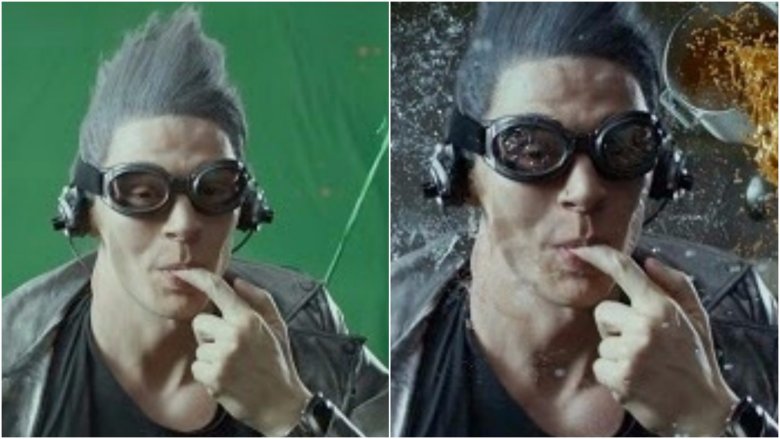
2014 was a big year for Marvel movies, with Fox also releasing their eagerly awaited X-Men sequel Days of Future Past. As Marvel prepared to introduce Aaron Taylor-Johnson as the MCU’s Quicksilver in Avengers: Age of Ultron, Fox exercised their right to use X-Men characters by having Evan Peters portray the lightning-fast mutant in Days of Future Past. The film earned rave reviews and Peters was a standout, with one scene in particular grabbing headlines.
The super slow-mo kitchen scene looked amazing, but it wasn’t at all easy to achieve. The sequence had to be shot at a mind-blowing 3600 frames per second, which requires huge amounts of light to work. “It was incredibly bright,” Peters told i09. “A lot of the crew and Bryan [Singer, director] got to wear sunglasses. And the actors had to keep their eyes open for a long, long time, with that bright light just blaring at you. It’s like the sun. It’s brighter than the sun. It’s right there in your eyes. But the end result is so worth it. You just power through it.”
Avengers: Age of Ultron (2015) – Under the armor
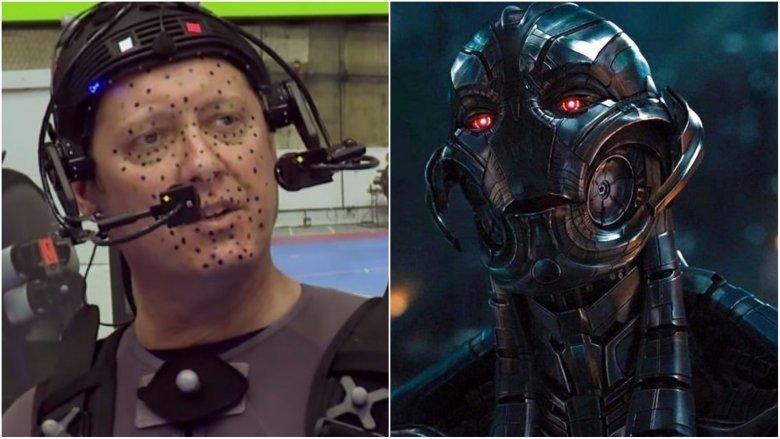
If there’s been one chief criticism of Marvel movies over the years, it’s that they have a problem making compelling villains. In order to combat that, James Spader was zipped into a motion capture suit and given the freedom to breathe some life into Ultron, the titular villain in the Avengers’ second group outing. “They had me go through a range of motions, very specific motions and movements which they captured with all these sensors and reference cameras,” Spader said. “Within ten minutes the rough image of Ultron was on a monitor in front of me.”
Spader’s performance was so compelling that it inspired the VFX team to make tweaks to their design. “Ultron Prime’s design needed to be modified to accommodate all of the acting and sophisticated motions James Spader was giving us on set,” ILM’s Ben Snow told Art of VFX. “The main challenge was getting the subtleties and character of James Spader’s on-set Ultron performance onto a character whose face and body are made up of rigid pieces of metal—the face alone had 600 nodes of rigging.”
Ant-Man (2015) – Little hero, big FX job
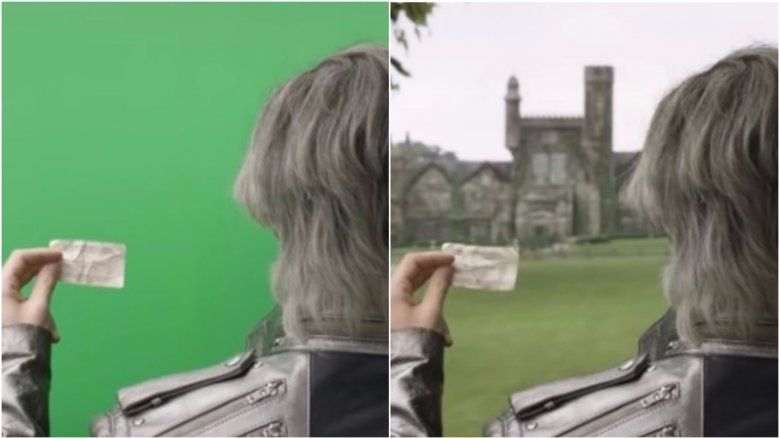
Ant-Man didn’t rely on CGI quite as much as some other Marvel movies, but with 1,619 visual effects shots, it was still a huge undertaking. The trickiest part wasn’t creating photo-real macro scale landscapes for Scott Lang (Paul Rudd) to scurry around on; according to visual effects supervisor Jake Morrison, it was the split second in which he shrinks that caused the most headache. “Because it’s such a subjective effect—and highly dependent on the environment Ant-Man is in, the camera angle he’s shot from, and the direction of travel—this proved to be one of the hardest effects to coordinate between all of the different vendors,” Morrison told Art of VFX.
Director Peyton Reed watched films like The Incredible Shrinking Man and Honey, I Shrunk the Kids for inspiration, hoping to create what he described as a “definitive shrinking movie” during an interview with Collider. He was more than happy with the results, praising the team of VFX artists that Morrison enlisted. “I was thrilled with where we ended up with the visual effects,” he said. “One of the things with Marvel is that you’re just surrounded by the top people, in all the fields. In visual effects, they did some amazing work.”
X-Men: Apocalypse (2016) – When is a castle not a castle?
Unlike the previous X-Men instalment, 2016’s Apocalypse didn’t go down well with the critics. Days of Future Past was Certified Fresh on Rotten Tomatoes, but it’s sequel was trashed in the majority of reviews, only managing a 48 percent approval rating on the website. There were some advances in technology in the time between the two movies, which allowed for “more seamless visual effects” according to Bryan Singer, but the director still chose to approach the film’s big set piece as practically as possible.
The Quicksilver super slow-mo evacuation scene upped the ante from the kitchen scene in Days of Future Past, but Singer told Den of Geek that you’d be surprised just how much of it was real. “We did use certain visual effects, certain digital effects and explosive algorithms, but we also took multiple phantom 3D cameras and ran them in protective cases through physical explosions,” he explained. “We blew up our sets. We waited until we were done with them, and then blew them up. We flew the cameras through at 80mph rolling at 3000 frames per second.” It took six weeks to make what amounted to two minutes of film.
Deadpool (2016) – Buckle up
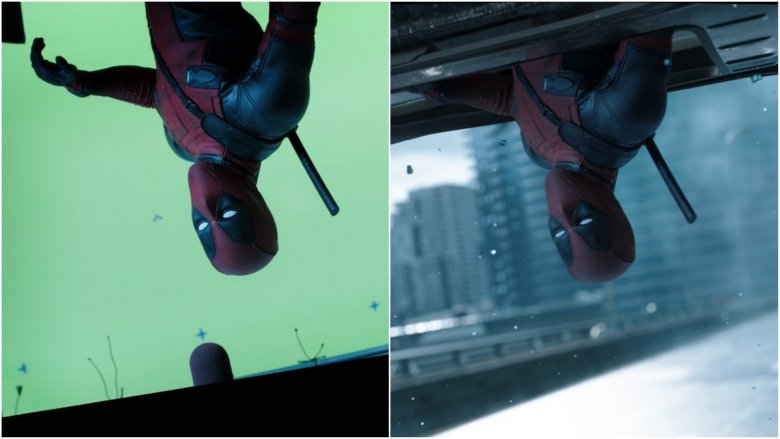
Jonathan Rothbart wasn’t a fan of the superhero genre when he was sent the screenplay for Deadpool, but after reading it, he knew right away that this wasn’t your regular superhero movie. “When I first read the script, I was laughing so hard,” the film’s overall VFX supervisor told AWN. “My wife kept on asking, ‘What are you laughing at?’ I told her, ‘This script is amazing. It’s so funny.'” Knowing that director Tim Miller had a background in animation himself, Rothbart signed up.
“Jonathan’s great and he knew exactly what we were going for so I knew I didn’t need to micromanage him,” Miller told Art of VFX. “It was an easy alliance and because I come from the VFX world, I think there was a shorthand to problem-solving on set.” One of the film’s standout VFX scenes was the bridge crash, a freeze frame from which was also used in the opening sequence. Pauline Duvall from Blur Studios revealed that the accompanying titles (which instead of names included things like “a CGI character” and “a British villain”) were put in place as a joke when only Ryan Reynolds had been cast, but both Reynolds and Miller loved them and decided to keep them in the final cut.
Doctor Strange (2016) – It’s magic
French-Canadian VFX artist Stephane Ceretti received his second Oscar nomination for the mind-blowing effects in Doctor Strange, Benedict Cumberbatch’s debut as the character and the introduction of magic to the MCU. Ceretti turned to Christopher Nolan’s similarly themed blockbuster Inception for guidance, but was also inspired by the work of graphic artist M. C. Escher and the psychedelic Strange Tales comics from Steve Ditko’s time at Marvel. “It was going from Guardians, where we went into the galaxy, and this one was about going into new dimensions,” he told Deadline. “So that was really exciting for me, trying to go into a new part of the Marvel Cinematic Universe.”
Approximately 1,450 visual effects shots had to be rendered in a six-month post schedule according to Ceretti, who revealed just how tricky the process was in an interview with AWN. “Conceptually, the movie was very difficult to pull off because there were lots of things that Marvel had never tried before,” he said. “The biggest challenge was to bring magic to the Marvel Cinematic Universe in a fresh and innovative way.” Ceretti must have enjoyed the challenge—he went on to supervise the visual effects for Ant-Man and the Wasp.
Logan (2017) – Logan’s death
Logan was a milestone movie in Fox’s long-running X-Men franchise, not only because it was Hugh Jackman’s final bow as the Wolverine, but also because it was the first time we got to see the clawed mutant in R-rated action. The levels of violence on display were like nothing we’d seen before in the X-Men universe, and this meant the VFX team had their work cut out for them. Rising Sun Pictures’ VFX supervisor Dennis Jones (whose company worked on both Days of Future Past and Apocalypse as well as 2013’s The Wolverine) relished the challenge.
“Logan is more brutal, visceral, and has direct consequences for the characters involved,” Jones told Art of VFX. “The R rating that was confirmed from the start introduced another dynamic to play with, albeit in a restrained fashion. In The Wolverine, some of our shots had to be amended to remove blood and claw penetration, so it was great to be able to [set] the character free from these constraints.” Makeup designer Joel Harlow told The Verge that “the level of physical trauma in this film is something I haven’t had to contend with since the early years when I was smearing blood around.”
Guardians of the Galaxy Vol. 2 (2017) – Mary Poppins
Guardians of the Galaxy: Vol 2’s visual effects supervisor Chris Townsend wasn’t part of the team that created the first Guardians movie, but he had previously worked with Marvel on Captain America: The First Avenger and Iron Man 3, receiving an Oscar nomination for the latter. When offered the opportunity to oversee the Guardians sequel, Townsend jumped at the chance to get back into the Marvel Cinematic Universe. “I’m a huge fan of the films,” he told Rotoscopers. “I think from a creative and visual effects point of view, they’re some of the funnest stuff out there.”
For the film’s epic third act, Townsend accepted a bid from Weta Digital, who picked up the action right after Ego (Kurt Russell) reveals to Quill (Chris Pratt) that he gave his mother cancer. “From that point on, it is mostly our work,” Weta’s Guy Williams told Art of VFX. “We go all the way until Yondu and Quill rise above the planet as it is destroyed behind them.” The New Zealand-based VFX house had up to 490 staffers working on Guardians of the Galaxy: Vol 2 at one stage, according to Williams, who admitted to losing plenty of sleep over the highly complicated nature of the project.
Thor: Ragnarok (2017) – Taika rocks
Like Guardians of the Galaxy, Thor: Ragnarok is a film that surpassed box office expectations with an overwhelming amount of its superhero action created digitally. According to VFX supervisor Jake Morrison, there were almost 2,700 digitally enhanced shots in the movie. “I believe about 98 percent of the film passed through the visual effects department’s hands,” he told Art of VFX. “We initially broke the film down into four key vendors who were with us from the beginning… By the end of the movie we had 18 separate vendors across the planet.”
Morrison spoke to IndieWire about supervising such a huge visual effects department, revealing that one of the most difficult tasks was making Korg (played by director Taika Waititi in a scene-stealing role) look believable. “The trouble with a character made of rocks is, even if there’s a hint of any individual rock squashing or stretching, it looks like a dude in a latex suit,” Morrison said. “But if the rocks move too technically and cleanly apart, it looks like clockwork. So there’s this really fine line in the artistry where you’ve got to build multiple layers of rocks and skin.”
Black Panther (2018) – King T’Challa’s ride
If you’re the King of Wakanda, you have to ride in style. And with the world’s largest supply of the miracle metal vibranium at your disposal, a Rolls Royce or even an Air Force One-style Boeing 747 simply won’t do.
When King T’Challa arrived in Wakanda from his diplomatic journeys abroad, he did so on a super-sleek stealth jet that looks like it came right out of Area 51. You wouldn’t know that if you were just watching the raw dailies, though. In the original footage, there was no jet, no landing platform — heck, there wasn’t even any Wakanda. There were just the actors and a blue screen in the background. We can picture director Ryan Coolger probably giving directions along the lines of: “Okay, so imagine you’re at Roswell, but it’s Africa, and you’ve seen this all many times before, so it’s not amazing to you.”
The final movie was amazing, though — the result of effects work from 12 VFX studios, all under the direction of Geoff Baumann, VFX Supervisor at Marvel Studios. Industrial Light & Magic, the company founded by George Lucas and known as ILM for short, handled 403 shots in the film, including this one. Clearly the VFX studio behind Star Wars was the perfect pick to handle pretty much all the complex VFX needed to bring the vibranium-powered capital city of Wakanda to life.
Black Panther (2018) – Winston Duke’s blues
It’s a good thing the gargantuan Winston Duke is 6’5″ and already looks like a king, because if not for his regal presence, this scene would have looked quite silly on set. In addition to a massive man dressed in fur, there was really nothing else but a sea of blue. RiseFX created the snowy, mountainous landscape where T’Challa winds up after losing his crown to his crazed cousin Erik Killmonger. RiseFX worked on 180 shots in Black Panther, mostly focusing on the Jabari sequences, as well as establishing shots for each setting in the film. We’d say their work was pretty darn convincing.
Black Panther made $700 million domestically and $1.3 billion worldwide, making it one of the most successful superhero movies ever. Black Panther was also the first superhero movie to be nominated for Best Picture at the Academy Awards. It didn’t win the gold, but being nominated was just like wearing the crown, and with Black Panther 2 set to open on May 6, 2022, we’d say things are looking up for the King of Wakanda.
Avengers: Infinity War (2018) – Josh Brolin’s transformation
It’s a little jarring to see that the Mad Titan, the destroyer of civilizations, the wicked warlord Thanos, is actually… Josh Brolin wearing what looks like an overpriced, skin-tight biker’s outfit. All that’s missing are some sponsors’ logos and reflective shades, and he looks like one of those super-fit, middle-aged dudes in the midst of a mid-life crisis that you have to dodge in your car on Saturday mornings.
While Brolin didn’t have to wear space armor and paint his skin purple, he was very much present during filming thanks to the wonders of motion capture technology. Brolin had never done mo-cap before, but he saw the light after seeing what his future Avengers castmate Benedict Cumberbatch was able to do as Smaug in The Hobbit: The Desolation of Smaug. Brolin told SiriusXM, “I thought I was going to be behind a bunch of lights and a bunch of cameras, but it wasn’t like that. It was practical, working with people. It’s a phenomenal process.” Indeed, Brolin’s one-on-one interaction with his castmates added an extra layer of creepy credibility that made the Mad Titan that much scarier.
Avengers: Infinity War (2018) – These guys aren’t so scary after all
Cull Obsidian and Ebony Maw (a.k.a. Squidward, according to Tony Stark) do not look like two dudes you’d want to run into in a dark alley. Or any alley, for that matter. Much like Thanos, however, the reality was much less intimidating than the fiction. Terry Notary played the mighty Cull Obsidian in a mo-cap suit that made him look like he was out spelunking on the set of Tron. Notary also did the movements for Teen Groot in Avengers: Infinity War, proving he can play teen angst in a tree, which arguably makes him the best actor to ever live. Notary is no stranger to mo-cap work, as he has “appeared” as Kong in Kong: Skull Island and Rocket in the new Planet of the Apes. So if you need a giant ape (or a giant green, space-alien reptile monster), Notary is your man.
Avengers: Infinity War (2018) – Stormbreaker’s maker
One of the most memorable parts of Avengers: Infinity War was Peter Dinklage’s performance as Eitri, the King of the Dwarves. Peter Dinklage is always awesome, but here, the actor — who only stands about 4’4″ — was playing a 20-foot giant who would bump his head on most bridge overpasses. The Lord of the Rings films famously used forced perspective to make people look like Hobbit-sized. This film used a different approach, and had Dinklage play opposite mini-cutouts of Thor, Groot and Rocket Raccoon. This makes Dinklage’s scene-stealing performance that much more impressive, as he was basically performing with dolls. Chris Hemsworth (who likewise was acting opposite characters who weren’t really there) would shoot his scenes on set, while blue screens would be brought in to shoot Eitri’s scenes. Now that you know this, you’re almost as smart as Dinklage’s most famous character, Tyrion.
Avengers Infinity War (2018) – Avengers assemble
What would a summer blockbuster be without an epic battle scene? Had this movie been directed by William Wyler, David Lean, or Cecil B. DeMille, they would have just dressed 10,000 extras up as aliens and had them pretend to fight a real battle. As awesome as that would have been, the filmmakers behind Avenges: Infinity War followed a more technologically advanced approach.
For starters, the scene was filmed on an 8,000-acre farm about 40 minutes outside Atlanta called Chattahoochee Hills Eventing. Instead of thousands of extras, only 70 performers were utilized, but they became more than 500 Wakandans digitally, and proceeded to do battle with Thanos’ army of 10,000 alien monsters known as Outriders, which were also digitally produced. The art department even added indigenous African trees and created an artificial river in the middle of the field, with a massive pump that was pumping up to 30,000 gallons per minute. Much like Revolutionary War and Civil War battle reenactments that are still being done today, we’d like to propose that Chattahoochee Hills becomes the site for future Battle of Wakanda reenactments, because we’d totally be down for that.
Avengers: Infinity War (2018) – Thor’s arrival
Thor’s arrival at the Battle of Wakanda may very well be the most epic superhero entrance ever. But when you see what it looked like before the CGI was added… well, it’s still pretty dang epic. Chris Hemsworth donned his full Thor attire and wielded a massive axe that just need a little CG love to become the mighty Stormbreaker. He obviously didn’t have a smack-talking, gun-toting raccoon on his shoulder for the shoot — or, for that matter, an angsty teenage tree, hundreds of Wakandan warriors, and an invading army of 10,000 alien monsters.
So yeah, most of the stuff in this scene was added after the fact. All the more reason to be impressed with Chris Hemsworth’s performance. It’s one thing to convincingly yell “bring me Thanos” when you’re actually doing battle with a giant army of outriders with a lightning-axe in your hand. It’s another when you’re having to play make-believe in a $10,000 Halloween costume.
Avengers: Infinity War (2018) – Go for the head
In the finished film, Thor’s epic showdown with Thanos in Avengers: Infinity War looks like a ferocious fight to the death between a Norse god and a Mad Titan. Alas, during the filming Chris Hemsworth looked like a bearded gym instructor beating up a grumpy middle-aged dad wearing head gear. Thor should have aimed for the head, but there’s no way he would have gotten past the camera in front of Josh Brolin’s face. You can see that in addition to his motion-capture contraption, Brolin was wearing a version of the Infinity Gauntlet on set. Good thing he knew how to snap his fingers, as that would have been awkward. Meanwhile, Hemsworth was wielding a Stormbreaker of sorts, albeit one that looks more like a piece of foam, and not the battle axe he had earlier. If you aim for the king, you best not miss. Especially if your axe isn’t actually an axe.
Avengers: Endgame (2019) – Professor Hulk
Following Hulk’s beatdown at the hands of Thanos in Avengers: Infinity War, Marvel fans were on the edges of their seats about what the future held for everyone’s favorite angry green giant. Nobody could have guessed it would be Professor Hulk. According to Animation Boss, Framestore breathed life into the Bruce Banner/Hulk hybrid. The process started by taking source footage of Mark Ruffalo and matching it to animation. This animation was then used for 60 shots, with head cam footage used for reference.
According to Animation Supervisor Max Solomon, “It was absolutely about channeling Bruce Banner. His face is very expressive. Every nuance, every little twitch and eye dart, slight curl of the lip and muscle tension needed to be translated.” Professor Hulk’s face was particularly challenging. According to VFX Supervisor Stuart Penn, “There was a lot of work involved as their face shapes are so different — Hulk is massive, his mouth proportionally bigger, his eyes are sunken with deeper sockets. Tiny changes to his face had a huge effect on the performance.” Sounds almost as complicated as sending a person back through time. Thankfully, the animators didn’t turn Mark Ruffalo into a baby, like Bruce Banner did to Ant-Man.
Avengers: Endgame (2019) – Thor’s wrath
If you need someone to go full-on primal rage mode with nothing but a foam rubber hammer and axe, and an awesome cosplay outfit, you call Chris Hemsworth. Even without the lightning effects and apocalyptic background added in, Hemsworth still does not look like someone you’d want to mess with, even if you happen to be a galaxy-conquering Mad Titan bent on destroying all life as we know it. After four Avengers and three Thor films, plus a smattering of cameos here and there, Hemsworth was more than used to playing make-believe, as this shot shows. He knew he could count on the VFX to make it come to life. And Avengers: Endgame certainly did have quite the lineup. According to Animation Boss, the VFX studios working on Avengers: Endgame were a veritable “who’s who” including ILM, Weta Digital, DNEG, Cinesite, Framestore, Digital Domain, Rise VFX, Lola VFX, Cantina Creative, Capital T, Technicolor VFX and Territory Studio.
Avengers: Endgame (2019) – Captain Marvel vs. Thanos
After wiping out half of all life in Avengers: Infinity War (and losing his head in the first 10 minutes of Avengers: Endgame), Thanos returns in Endgame’s final act, once again in possession of all the Infinity Stones and with final victory once more within his grasp. Alas, this is the first time the Mad Titan has gone up against against Captain Marvel. Only by using the Stones is he able to fend her off, but just long enough to open himself up to attack from Iron Man.
Fans had been eagerly anticipating Captain Marvel taking on Thanos ever since the post-credit scene to Avengers: Infinity War when Nick Fury contacted her on her intergalactic space beeper. After seeing what she was capable of in Captain Marvel, we knew the Mad Titan had met his match in Carol Danvers. Bringing this fight to life on set appears to have been considerably less epic than it wound up being on the big screen. But hey, that’s the magic of the movies for you. It does just go to show you how massive Thanos was, as the stunt man had to wear a giant, King Kong-sized chest pad to match Thanos’ pecs. Dude would have killed at a Mr. Universe competition, but only if they allowed evil aliens to enter.
Avengers Endgame (2019) – I am Iron Man
It was simultaneously one of the most heartbreaking and goosebump-inducing moments in the MCU when Tony Stark got ahold of the Infinity Stones and “snapped” Thanos out of existence, sacrificing his life in the process. The line “I am Iron Man” was first uttered 11 years prior in Iron Man, the film that launched the biggest franchise in history, and there couldn’t have been a better line for Tony Stark to go out on. Strangely enough, it almost didn’t happen.
According to directors the Russo brothers, “Tony used to not say anything in that moment. And we were in the editing room going, ‘He has to say something. This a character who has lived and died by quips.’ And we just couldn’t, we tried a million different last lines. Thanos was saying ‘I am inevitable.’ And our editor Jeff Ford, who’s been with us all four movies and is an amazing storyteller, said, ‘Why don’t we just go full circle with it and say ‘I am Iron Man.” And we’re like, ‘Get the cameras! We have to shoot this tomorrow.'” The scene turned out the be the last one filmed during Endgame reshoots, and the behind-the-scenes moment was thankfully captured by Downey’s assistant Jimmy Rich. We love this 3,000. Actually, strike that — we love it 5,000.
Spider-Man: Far From Home – Field PlaneMarvel StudiosOfficially the last entry in The Infinity Saga era of the MCU, “Spider-Man: Far From Home” hit cinemas the same year as “Avengers: Endgame” in 2019. The film sees Peter Parker (Tom Holland) travel to Europe with some of his classmates on a field trip before being recruited by Nick Fury (Samuel L. Jackson) and Mysterio (Jake Gyllenhaal) to help fight a mysterious race known as Elementals. Near the start of the story, Peter reunites with Happy Hogan (Jon Favreau) in a tulip field located in the Netherlands, who warns the young hero that Fury is trying to contact him.
With filming taking place in the U.K., though, getting the field to look like it was actually in the Netherlands required some CGI work. According to AWN, almost everything in this scene was rendered except for the windmill, Peter, and Happy. Millions of tulips were created using visual effects in addition to the Stark Jet landing in the field. The before and after shots show just how different the scene looked, with Favreau standing on a set of stairs.
VFX supervisor Joern Grosshans revealed that creating this fake tulip field was a time-consuming project because of the sheer amount of objects that needed to be rendered. “Every color had a variety of eight different tulips that were hand modeled, textured and crafted,” said Grosshans. “Then we procedurally scattered them. We had something like two million tulips.”
Read More: https://www.looper.com/100139/marvel-movies-really-look-like-special-effects-added/
